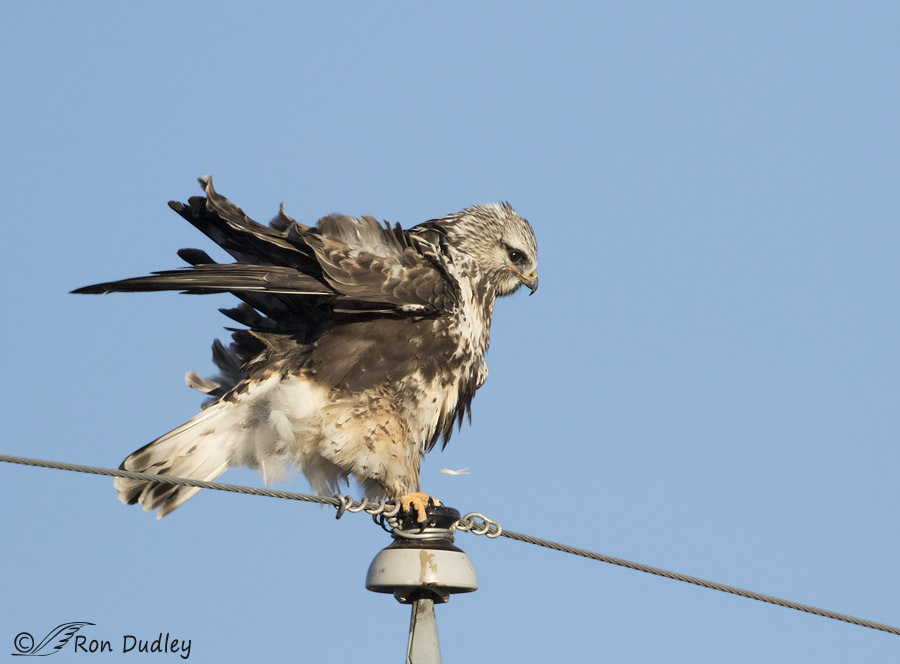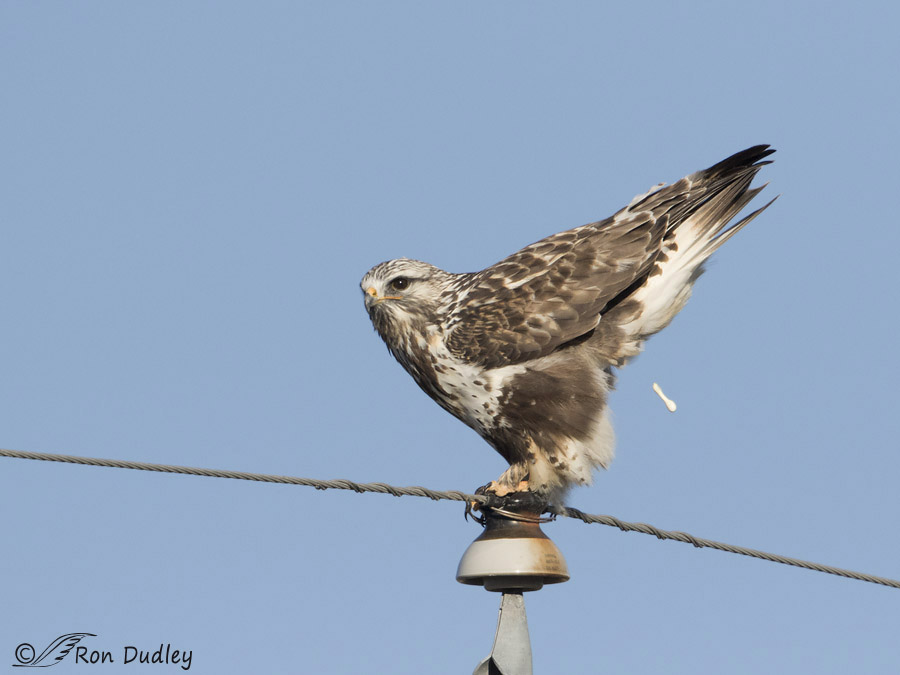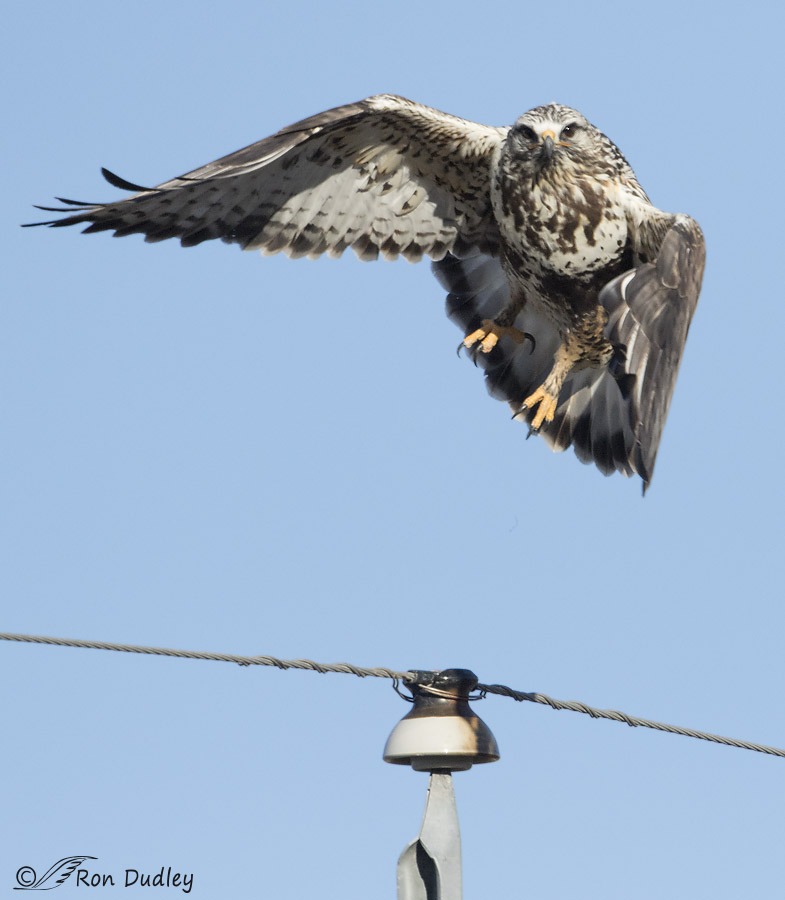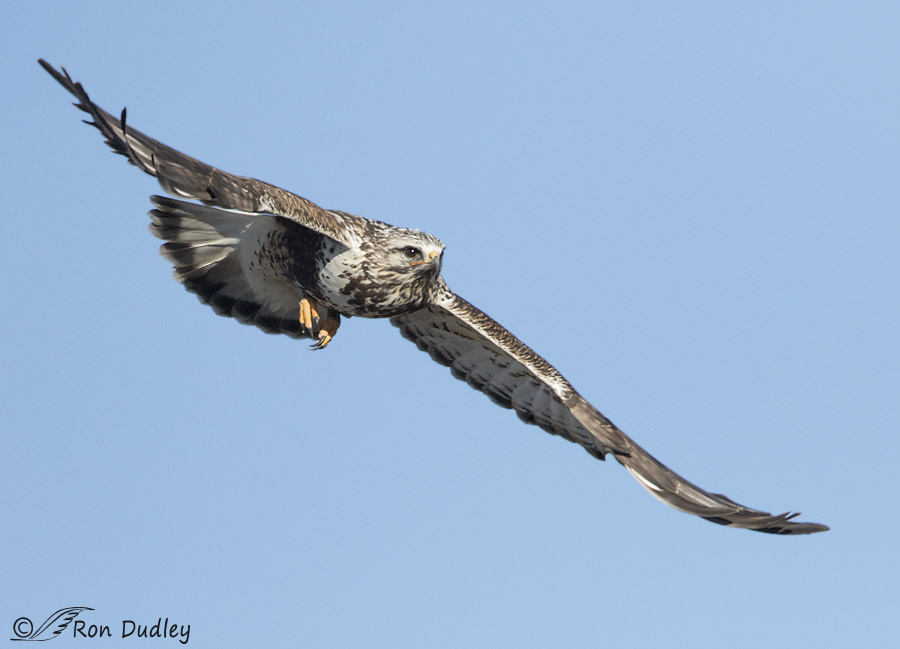Knowing behaviors of your subject can be a great help in anticipating raptor take-off and bird photographers need all the help we can get.
Raptors often (though not always) telegraph imminent take-off by a variety of behaviors. Knowing that your subject may be about to lift off allows the photographer time to adjust camera settings, anticipate direction of flight and prepare for quick action – it’s very difficult to maintain your “hair-trigger” for long periods of time.
Some of the behaviors that very often signal impending take-off include:
- turning into the wind on the perch
- stretching
- rousing (ruffling feathers)
- defecation

1/3200, f/6.3, ISO 500, Canon 7D Mark II, Canon EF500mm f/4L IS II USM +1.4 tc, not baited, set up or called in
I found this Rough-legged Hawk in Tooele County, Utah 6 days ago as it was hunting voles from power poles along a rural road. When the bird roused vigorously (to the point that it lost a feather) I figured that it would take off soon and it did but its direction of flight was away from me so I deleted all those shots.

1/5000, f/7.1, ISO 800, Canon 7D Mark II, Canon EF500mm f/4L IS II USM +1.4 tc, not baited, set up or called in
But 40 minutes later I found what I believe to be the same bird on a different pole and decided to try again. Eventually the bird pooped so I was fairly confident that it was about to take off. By now there was a noticeable south wind coming from behind me so I hoped the bird would turn on its perch and fly in my direction but it fooled me a little by waiting until the moment of take-off…

1/4000, f/7.1, ISO 800, Canon 7D Mark II, Canon EF500mm f/4L IS II USM +1.4 tc, not baited, set up or called in
and twisting toward me on its perch as it launched in my direction.

1/5000, f/7.1, ISO 800, Canon 7D Mark II, Canon EF500mm f/4L IS II USM +1.4 tc, not baited, set up or called in
As the hawk flew past me I was able to get several shots I like pretty well and this is one of them. (I should practice what I preach – it was a mistake to be at ISO 800 for most of these images)
This bird was acclimated to traffic along the road and would sometimes remain perched for a long time before leaving the pole. Like most nature photographers I’m not a fan of power poles as perches so I’d much rather get them in flight but it’s very difficult to maintain a “hair-trigger” for 10-20 minutes. So it’s extremely helpful to be able to anticipate take-off.
I’ve covered this subject in a previous post but I thing it’s worth an occasional revisit.
Ron
Note: It’s never a good idea to repeatedly “bump” a bird from perch to perch in order to get a photo. Doing so disturbs the bird and wastes its energy. While I was photographing this hawk I remained in my pickup and most traffic didn’t affect the birds behavior or make it leave its perch (although if a large, noisy truck came by the hawk would sometimes fly to another pole down the line).


Wonderful shots Ron!
Charlotte
Not only a superb series of quality images but a wonderful tutorial! Never worry about repeating past tips as we can all use a refresher! (Okay, I shouldn’t speak for everyone, but I know I can never get enough advice!)
Thanks very much, Wally.
Great shots, and I love the “twisty” one, as well — and you can really see those talons against the background of blue. Makes me think of spats! A beauty of a bird!
Ha, spats! Haven’t thought of those things for a long time, Chris. You’re right.
These are all beautiful shots, but I especially like the twisting one. It’s not a position I would expect to see in a photograph.
That posture is somewhat unusual, Susan. I enjoy it too.
Love the raggedy look of that bird in the first shot…looks like he left his feathers in the dryer too long!
“looks like he left his feathers in the dryer too long!”
Loved that, Patty!
Love the twisting in air launch shot Ron! Wow, what acrobats! And the last shot with the full wing span is wonderful as well!
Do you normally shoot with your iso at 800? I don’t remember seeing many posts with it set that high but it sure gives you a fast shutter speed!
All in all, you always inspire, Thank You!
Thanks, Alan. No, I don’t normally shoot with my ISO that high. As I said in my text, that was a mistake. I simply forgot to crank it down – another rookie mistake…
I simply forgot to crank it down – another rookie mistake…
Well Ron, you’re hardly a “rookie” but I think we all can have momentary lapse ;~). I call them “Brain Freeze’s” or “Brain Farts”, depending on the crowd, LOL.
They seem to come to me more ofter the older I get ;`)
Thank you for the great imagery, yours is a favorite site on the morning ;~) And Mia, you two are one & two in my book!
Alan
“They seem to come to me more often the older I get”
Me too, Alan. Me too…
I so appreciate your behavioral notes every day–even to new ( to me ) words like “rousing”—your blog is wonderful start to each morning !
I’m delighted to know that you begin your morning here, Kris. And that you appreciate the terminology. Thank you. r
My favorite is the third because of the way the hawk is turning. Really nice.
Thanks, Arwen.
Hi Ron, Nice images! And, I appreciate your great tips on raptor behavior and photography/birding etiquette (as always!). Thanks!
Cheers,
Dick
Thank you, Dick. They’re not my best images but they do illustrate my point(s).
love the the flight shots. Noticed 2 different shutter speeds on the 2 flight shots. What mode are you shooting? M, Av, Tv? And I see that you are shooting at a very high shutter speed. About the speed that I shoot for hummingbirds to freeze the wings without flash.
cheers
Rich
Thanks Richard. I always shoot in aperture priority. As I mentioned in my text, shooting at ISO 800 (thus the high SS) was a mistake.